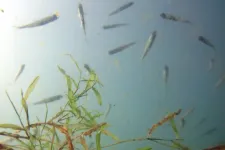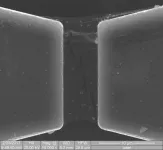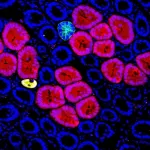(Press-News.org) TROY, N.Y. -- Oxygen levels in the world's temperate freshwater lakes are declining rapidly -- faster than in the oceans -- a trend driven largely by climate change that threatens freshwater biodiversity and drinking water quality.
Research published today in Nature found that oxygen levels in surveyed lakes across the temperate zone have declined 5.5% at the surface and 18.6% in deep waters since 1980. Meanwhile, in a large subset of mostly nutrient-polluted lakes, surface oxygen levels increased as water temperatures crossed a threshold favoring cyanobacteria, which can create toxins when they flourish in the form of harmful algal blooms.
"All complex life depends on oxygen. It's the support system for aquatic food webs. And when you start losing oxygen, you have the potential to lose species," said Kevin Rose , author and professor at Rensselaer Polytechnic Institute. "Lakes are losing oxygen 2.75-9.3 times faster than the oceans, a decline that will have impacts throughout the ecosystem."
Researchers analyzed a combined total of over 45,000 dissolved oxygen and temperature profiles collected since 1941 from nearly 400 lakes around the globe. Most long-term records were collected in the temperate zone, which spans 23 to 66 degrees north and south latitude. In addition to biodiversity, the concentration of dissolved oxygen in aquatic ecosystems influences greenhouse gas emissions, nutrient biogeochemistry, and ultimately, human health.
Although lakes make up only about 3% of Earth's land surface, they contain a disproportionate concentration of the planet's biodiversity. Lead author Stephen F. Jane, who completed his Ph.D. with Rose, said the changes are concerning both for their potential impact on freshwater ecosystems and for what they suggest about environmental change in general.
"Lakes are indicators or 'sentinels' of environmental change and potential threats to the environment because they respond to signals from the surrounding landscape and atmosphere. We found that these disproportionally more biodiverse systems are changing rapidly, indicating the extent to which ongoing atmospheric changes have already impacted ecosystems," Jane said.
Although widespread losses in dissolved oxygen across the studied lakes are linked to climate change, the path between warming climate and changing freshwater oxygen levels is driven by different mechanisms between surface and deep waters.
Deoxygenation of surface waters was mostly driven by the most direct path: physics. As surface water temperatures increased by .38 degrees Centigrade per decade, surface water dissolved oxygen concentrations declined by .11 milligrams per liter per decade.
"Oxygen saturation, or the amount of oxygen that water can hold, goes down as temperatures go up. That's a known physical relationship and it explains most of the trend in surface oxygen that we see," said Rose.
However, some lakes experienced simultaneously increasing dissolved oxygen concentrations and warming temperatures. These lakes tended to be more polluted with nutrient-rich runoff from agricultural and developed watersheds and have high chlorophyll concentrations. Although the study did not include phytoplankton taxonomic measurements, warm temperatures and elevated nutrient content favor cyanobacteria blooms, whose photosynthesis is known to cause dissolved oxygen supersaturation in surface waters.
"The fact that we're seeing increasing dissolved oxygen in those types of lakes is potentially an indicator of widespread increases in algal blooms, some of which produce toxins and are harmful. Absent taxonomic data, however, we can't say that definitively, but nothing else we're aware of can explain this pattern," Rose said.
The loss of oxygen in deeper waters, where water temperatures have remained largely stable, follows a more complex path most likely tied to increasing surface water temperatures and a longer warm period each year. Warming surface waters combined with stable deep-water temperatures means that the difference in density between these layers, known as "stratification," is increasing. The stronger this stratification, the less likely mixing is to occur between layers. The result is that oxygen in deep waters is less likely to get replenished during the warm stratified season, as oxygenation usually comes from processes that occur near the water surface.
"The increase in stratification makes the mixing or renewal of oxygen from the atmosphere to deep waters more difficult and less frequent, and deep-water dissolved oxygen drops as a result," said Rose. Water clarity losses were also associated with deep-water dissolved oxygen losses in some lakes. However, there was no overarching decline in clarity across lakes.
Oxygen concentrations regulate many other characteristics of water quality. When oxygen levels decline, bacteria that thrive in environments without oxygen, such as those that produce the powerful greenhouse gas methane, begin to proliferate. This suggests the potential that lakes are releasing increased amounts of methane to the atmosphere as a result of oxygen loss. Additionally, sediments release more phosphorous under low oxygen conditions, adding nutrients to already stressed waters.
"Ongoing research has shown that oxygen levels are declining rapidly in the world's oceans. This study now proves that the problem is even more severe in fresh waters, threatening our drinking water supplies and the delicate balance that enables complex freshwater ecosystems to thrive," said Curt Breneman, dean of the School of Science. "We hope this finding brings greater urgency to efforts to address the progressively detrimental effects of climate change."
"Widespread deoxygenation of temperate lakes" was published with support from the National Science Foundation. Rose and Jane were joined by dozens of collaborators in GLEON, the Global Lake Ecological Observatory Network, and based in universities, environmental consulting firms, and government agencies around the world.
INFORMATION:
About Rensselaer Polytechnic Institute
Founded in 1824, Rensselaer Polytechnic Institute is America's first technological research university. Rensselaer encompasses five schools, 32 research centers, more than 145 academic programs, and a dynamic community made up of more than 7,900 students and over 100,000 living alumni. Rensselaer faculty and alumni include more than 145 National Academy members, six members of the National Inventors Hall of Fame, six National Medal of Technology winners, five National Medal of Science winners, and a Nobel Prize winner in Physics. With nearly 200 years of experience advancing scientific and technological knowledge, Rensselaer remains focused on addressing global challenges with a spirit of ingenuity and collaboration. To learn more, please visit http://www.rpi.edu.
Chinese researchers realized an elementary link of a quantum repeater based on absorptive quantum memories (QMs) and demonstrated the multiplexed quantum repeater for the first time. On June 2nd?the work is published in Nature.
The fundamental task of a quantum network is to distribute quantum entanglement between two remote locations. However, the transmission loss of optical fiber has limited the distance of entanglement distribution to approximately 100 km on the ground. Quantum repeaters can overcome this difficulty by dividing long-distance transmission into several short-distance elementary links. The entanglement of two end nodes of each link is created firstly. Then the entanglement distance is gradually expanded through entanglement swapping between each link.
Previously, an ...
HOUSTON - (June 2, 2021) - It's official: Hexagonal boron nitride (h-BN) is the iron man of 2D materials, so resistant to cracking that it defies a century-old theoretical description engineers still use to measure toughness.
"What we observed in this material is remarkable," said Rice University's Jun Lou, co-corresponding author of a Nature paper published this week. "Nobody expected to see this in 2D materials. That's why it's so exciting."
Lou explains the significance of the discovery by comparing the fracture toughness of h-BN with that of its better-known cousin ...
The study, published in the journal Nature, shows how a drug available on the NHS can boost fitness of healthy stem cells in the gut, making them more resistant to sabotage from mutant stem cells that cause cancer.
Researchers in the Netherlands, funded by the UK charity Worldwide Cancer Research, have discovered a way to boost the fitness of healthy cells in the gut to prevent the development of bowel cancer. The findings have led to the initiation of a clinical trial to find out if a commonly used psychiatric drug could be used to prevent bowel cancer in people. The trial will recruit patients with a genetic mutation that means they are virtually 100% certain to develop bowel cancer in their lifetime, unless ...
Metastases can develop in the body even years after apparently successful cancer treatment. They originate from cancer cells that migrated from the original tumor to other organs, and which can lie there inactive for a considerable time. Researchers have now discovered how these "sleeping cells" are kept dormant and how they wake up and form fatal metastases. They have reported their findings in the journal Nature.
A tumor can leave behind an ominous legacy in the body: cancer cells can migrate from the tumor to other tissues in the body, where they survive after treatment in a kind of hibernation called dormancy. Currently, cancer medicine relies on monitoring cancer patients ...
Studies on cancer are limited by the threshold at which cellular transformations become clinically detectable. However, the very initial phase on the way to malignancy is histologically invisible, as the process originates from one single cell. In this early phase, a so-called "seeding cell" acquires an initial pro-cancerous mutation, also known as the "first oncogenic hit", while being completely surrounded by normal tissue. To overcome the detection barrier, a team of researchers around IMBA group leader Bon-Kyoung Koo and University of Cambridge group leader Professor Benjamin D. Simons developed a laboratory system to dissect the pre-cancerous steps that remained under the radar ...
A team of researchers led by the University of Cambridge and University of Utrecht examined trends in daily crime counts before and after COVID-19 restrictions were implemented in major metropolitan areas such as Barcelona, Chicago, Sao Paulo, Tel Aviv, Brisbane and London.
While both stringency of lockdowns and the resulting crime reductions varied considerably from city to city, the researchers found that most types of crime - with the key exception of homicide - fell significantly in the study sites.
Across all 27 cities, daily assaults fell ...
Clinical trials published in high-profile medical journals rarely report on income or other key sociodemographic characteristics of study participants, according to a new study that suggests these gaps may create blind spots when it comes to health care, especially for disadvantaged populations.
The study, publishing June 2 in JAMA Network Open, analyzed 10 per cent of 2,351 randomized clinical trials published in New England Journal of Medicine, JAMA, The BMJ, The Lancet and Annals of Internal Medicine between Jan. 1, 2014 and July 31, 2020.
The most commonly reported sociodemographic variables were sex and gender (in 98.7 per cent of trials) and race/ethnicity (in 48.5 per cent). All other sociodemographic ...
Experts at the Alfred Wegener Institute have, for the first time, experimentally measured the release of iron from the fecal pellets of krill and salps under natural conditions and tested its bioavailability using a natural community of microalgae in the Southern Ocean. In comparison to the fecal pellets of krill, Antarctic phytoplankton can more easily take up the micronutrient iron from those produced by salps. Observations made over the past 20 years show that, as a result of climate change, Antarctic krill are increasingly being supplanted by salps in the Southern Ocean. In the future, salps could more effectively stimulate the fixation of the greenhouse gas carbon dioxide in Antarctic microalgae than krill, as the team of researchers report ...
Peer reviewed
Experimental study / Meta-analysis
Animals / Human data
Protein disguise could be new target for cancer immunotherapy
Researchers at the Francis Crick Institute have identified a protein that helps tumours evade the immune system and, in certain types of cancers, is linked to a poorer chance of survival. The protein could become a target for future cancer treatments.
A crucial part of the immune system's response to cancer is a group of white blood cells, called CD8+ T-cells, which kill tumour cells. Before they launch their anti-tumour response, these cells must be told who to attack by another immune cell, ...
They studied the extent to which cirrus clouds caused by aircraft occurred during the global hard lockdown between March and May 2020, and compared the values with those during the same period in previous years. The study was led by Johannes Quaas, Professor of Theoretical Meteorology at Leipzig University, and has now been published in the renowned journal "Environmental Research Letters".
Cirrus clouds, known for their high, wispy strands, contribute to warming the climate. When cirrus clouds occur naturally, large ice crystals form at an altitude of about 36 kilometres, in turn reflecting sunlight back into space - albeit ...




